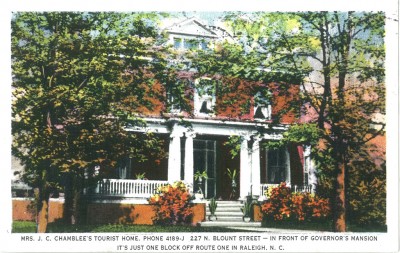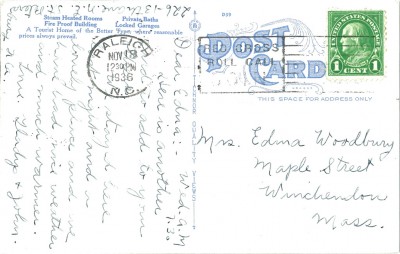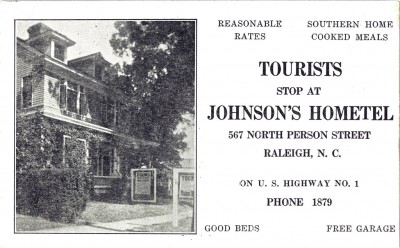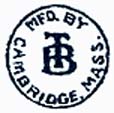Mrs. Chamblee’s Tourist Home, Raleigh, N.C.
This week Flashback Friday revisits the ‘tourist home’ era of Raleigh’s US Highway 1 north/south corridor through town. We’ve traveled this route before in earlier posts, so visit with us again this week as we stop in at Mrs. Chamblee’s Tourist Home on Blount Street.
Wed a.m. 7.36
Dear Edna:
Here is another card to add to your others.
We stayed here last night and a lovely place and we have had nice weather and much warmer.
Love, Gladys & John
226 – 13th Ave. N.E. St. Petersburg Fla.
Gladys and John certainly seemed to have enjoyed their stopover in Raleigh at Mrs. Chamblee’s, if that run-on sentence is any indication. Given the St. Petersburg destination address, the couple were apparently among the ‘snowbird’ migrants from New England headed to Florida for the winter.
Raleigh’s Tourist Home Corridor
Following the advent of automobile travel among the American public in the 1920s and ’30s and the designation of US Route 1 as the north/south highway artery through North Carolina in 1926, ‘tourist homes,’ or what we would call bed and breakfasts today, popped up along the route through Raleigh. By the late 1930s, a good dozen operated along Person Street, with several others opening up on adjacent Blount and Edenton Streets, as well.
Johnson’s Hometel was a popular stopover along the tourist home corridor. Like many such establishments, Johnson’s offered “reasonable rates, Southern home-cooked meals, good beds,” and off-street parking.
Although a few tourist homes still operated in Raleigh well into the 1950s, their popularity among the traveling public began to wane during that decade with the emergence of the American motel phenomenon and rising popularity of air travel.
The Saga of Mrs. Chamblee’s Tourist Home
Patty Chamblee ran her hostelry at 227 N. Blount St. for much of the decade of the 1930s. She had married Raleigh policeman Joseph Chamblee around 1927. In 1930 the couple bought the brick house on the corner of Blount and Lane Streets, “in front of the Governor’s Mansion.”
By 1933 Joseph was no longer on the police force, and was working as a traveling salesman. Perhaps it was because of her husband’s loss of a steady income and the generally hard times of the Great Depression that Patty opened her tourist home. She apparently received paying guests at 227 N. Blount until the end of the decade.
For whatever reason, the Chamblees moved from 227 in 1940 for a short stint at the Mansion Park Hotel across the street. In 1941 they moved to 1604 Hillsboro St. where Patty operated a rooming house until after World War II.
Back at 227 N. Blount, a Mrs. Gertrude Harper was offering furnished rooms for rent. During the 1940s the hostelry was known as the Guest House Tourist Home. By 1950 the house had been split up into four individual apartments, and thus it remained until the building was demolished in 1966.
From what had once been a premier residential address in the late 19th and early 20th centuries, Blount Street began a downward spiral in the 1950s, with many of its grand homes being converted to apartments and rooming houses. During the 1960s the state of North Carolina demolished most of them, with the intent of using the property for state government office buildings. It was a sad blow to the architectural legacy of the city of Raleigh.
This aerial photo of the recently completed Legislative Building, taken in 1963, shows many of the grand homes that once lined Blount St. Mrs. Chamblee’s Tourist Home can be seen at the right of the frame, the last one in the row across the street from the Governor’s Mansion.
Our Flashback Friday postcard this week is an early white border, ‘linen finish’ type. It was printed by Tichnor Brothers of Boston.
Tichnor Brothers, Inc.  (1912-1987)
160 N. Washington Street, Boston and Cambridge, MAA major publisher and printer of a wide variety of postcards types. Their view-cards were produced on a national level.
Their photochomes went under the trade name Lusterchrome. They also produced an early Tichnor Gloss series in offset lithography that was so heavily retouched they floated somewhere between being artist drawn and being a photograph. The company was sold in 1987 to Paper Majic.
‘Linen Finish’ Postcards
Linen is a reference to a postcard that has a linen-like fabric texture embossed into its front surface. The Curt Teich Company of Chicago was the first to use this texture for large scale production starting in 1931. They were printed as tinted halftones in both lithography and line block. Their linen texture exposed more surface area to the surrounding air speeding up drying time, which in turn allowed more colorful dye based inks to be used on high-speed presses. Different printers of linen cards usually had their own individual die to emboss their signature texture into the paper. Though printed alongside photochromes for many years, the use of linens ended in by 1959 as chromes became more popular with the public.
“Flashback Friday†is a weekly feature of Goodnight, Raleigh! in which we showcase vintage postcards depicting our historic capital city. We hope you enjoy this week end treat!
Â






 Sign up for the Newsletter
Sign up for the Newsletter
05/17/2014
I remember one on Person Street that was operating well into the 60’s and another on Hillsborough that lasted much longer as well. By then, they housed some interesting characters!
05/18/2014
Look at all those beautiful homes in that aerial! I have told people, while driving down Blount and Person, that the streets were once lined with beautiful old houses. An unbelievable “Reaaaally?” is the usual response. One friend said while going down Blount one day, “Why would you want to live in the shadow of all those ugly buildings?”
05/20/2014
Some of the Chamblee’s front yard bricks appear to have survived up against the new sidewalk at that corner. By the way that aerial, while impressive, is missing the grandest home from that block that sat in the middle on that central cleared area…one of the Thomas Devereux Hogg It was antebellum…much greater loss than a row of 1920’s homes. http://ncpedia.org/biography/hogg-thomas-devereux
Also he had quite a grisly death discussed on haloween 2013 in the N&O. http://www.newsobserver.com/2013/10/20/3299030/shaffer-three-chopped-up-ghosts.html